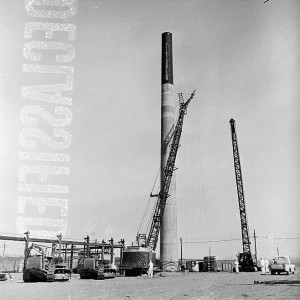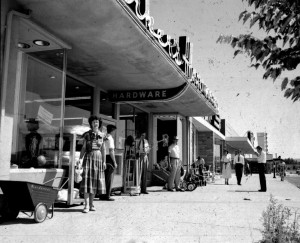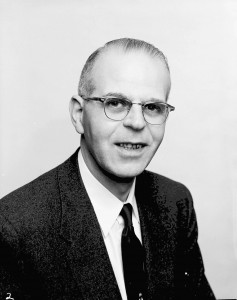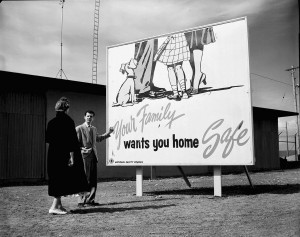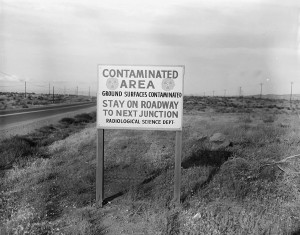“Augean Suite”
Herbert Parker (1910-1984) started the Health Physics program at the Hanford Works in 1944, charged with designing and implementing radiation monitoring systems for both workers (who must remain within “permissible” exposure limits that he, in part, established) and the downstream and downwind environment. Parker created standards and methods in an industry that had never before existed. His team brought back proof of new and unforeseen contamination every day; monitoring must have been—I think, looking back—a terrifying adventure. Parker embraced and advanced secrecy, and worried in now-declassified memos that an action like closing the Columbia River to fishing (in the 1950s, sediments, fish, and water samples tested well above the radiation exposure limits he helped set) or evacuating public lands (a particularly alarming stack problem at Redox Plant in 1954 resulted in widespread airborne radioruthenium contamination large enough to see with the naked eye) would do irreparable “public relations” damage. Armed with his own calculations that scuttled “overly conservative” safety factors, Parker invariably erred toward maintaining morale.
The italicized sections of “Augean Suite” are in Herbert Parker’s own voice. I am fascinated by his tendency to repeat language (a kind of double speak evident in Part V) and his taste for grand—mythic—verbal gestures. (Kathleen Flenniken)
Editors’ note: The accompanying photographs are not part of the original text of the poem, and are publicly available at The Hanford Declassification Project archives. The images, including those of Herbert Parker, appear unaltered from the archives.
—
Augean Suite
I. The Fifth Labor of Hercules
Augeus’s vast herds of cattle were divine
but their shit was earthly,
and divinely abundant.
The stench hung over the valley,
palpable. Nobody
waded into the fouled stable
without drowning.
This gave Hercules his idea
to divert two rivers,
the Alpheus and the Peneus,
and sluice the filth away,
which he finished in a single day.
Then he slew King Augeus
to remind us the world belongs
to gods and kings,
that exacting justice is worthier
than atoning for sins.
No more mention
of the two gangrenous rivers,
the women downstream washing clothes
or their children bathing.
II. Augean Gray, 1954
Flakes emitted from the process stack
could be discerned by the eye
the way one might hear the taps
of countless leather soles
treading a busy bus lot
and yet not attend them—
not notice their drift and fall.
Say the click of my mother’s heels
as she pushed one baby in a carriage
and pulled another by the hand
through the nearby village in August—
as it snowed radioruthenium.
She wouldn’t know to listen.
If only she’d thought to ask
why snow fell that summer.
If only the villagers had asked
why 17,000 signs were erected
all over the desert to
Keep Off the Grass.
III. Internal Report, Herbert M. Parker, 1954
IV. Augean Gray
Women,
take off your
dresses
and undergarments.
You babies,
crawl naked
in the grass.
Lie down all of you
under the August sky,
and nobody ask.
Questions alarm
and weaken
our nation.
It is snowing.
Your men are at workmaking snow.
I will go first
and close my eyes,
cross the distance
between here
and winter.
Lie down, patriot.
Don’t ask.
V. The Graying of Herbert Parker, 1956
There will be through the course of the years
a very slow build-up, he said.
One knows the final answer only some 10,
20, or 30 years from now. He said, Perhaps
by the time the deposit becomes a hazard
the true permissible levels will be known,
and the word permissible was downy
as fine snow. It is rather easy to show, he said,
an undesirable tendency to concentrate where
least desired. As though Jack Frost had touched
his mind. The obvious hazard is not always—
the flakes started falling in earnest—one might
almost dare to say not usually—the real hazard.
While snow drifted behind his eyes.
VI. Herbert Parker’s Statement to Congress, 1962
REPRESENTATIVE HOSMER. Do you have a color chart with you?
MR. PARKER. I am not able to put precise numbers on these shades of gray but I classify Arcadian gray as pure and clean for the relevant purpose, and Augean gray containing a reference to the well-known stables of history, and the middle range, if I may clarify that, as I recall Achilles, he was pretty sound but he had a couple of weak spots, one on each heel.
—
Kathleen Flenniken’s second poetry collection, Plume, about the Hanford nuclear site, was selected by Linda Bierds for the Pacific Northwest Poetry Series and is available now from University of Washington Press. Her honors include fellowships from the NEA and Artist Trust, an ALA Notable Book Award (for her first collection, Famous), and a 2012 Pushcart Prize.
—
“Augean Suite” appeared originally in Poetry Northwest v6.n2 (Fall & Winter 2011-2012).

